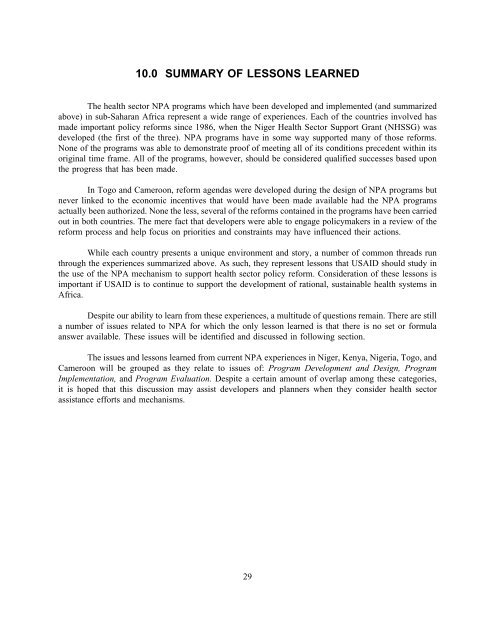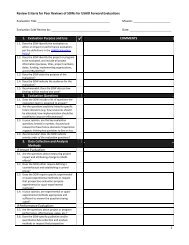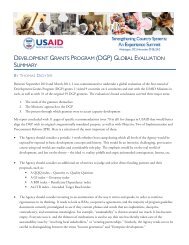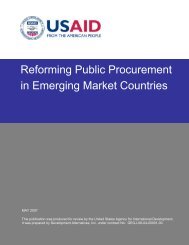Study on USAID Non-Project Assistance Programs in
Study on USAID Non-Project Assistance Programs in
Study on USAID Non-Project Assistance Programs in
You also want an ePaper? Increase the reach of your titles
YUMPU automatically turns print PDFs into web optimized ePapers that Google loves.
10.0 SUMMARY OF LESSONS LEARNEDThe health sector NPA programs which have been developed and implemented (and summarizedabove) <strong>in</strong> sub-Saharan Africa represent a wide range of experiences. Each of the countries <strong>in</strong>volved hasmade important policy reforms s<strong>in</strong>ce 1986, when the Niger Health Sector Support Grant (NHSSG) wasdeveloped (the first of the three). NPA programs have <strong>in</strong> some way supported many of those reforms.N<strong>on</strong>e of the programs was able to dem<strong>on</strong>strate proof of meet<strong>in</strong>g all of its c<strong>on</strong>diti<strong>on</strong>s precedent with<strong>in</strong> itsorig<strong>in</strong>al time frame. All of the programs, however, should be c<strong>on</strong>sidered qualified successes based up<strong>on</strong>the progress that has been made.In Togo and Camero<strong>on</strong>, reform agendas were developed dur<strong>in</strong>g the design of NPA programs butnever l<strong>in</strong>ked to the ec<strong>on</strong>omic <strong>in</strong>centives that would have been made available had the NPA programsactually been authorized. N<strong>on</strong>e the less, several of the reforms c<strong>on</strong>ta<strong>in</strong>ed <strong>in</strong> the programs have been carriedout <strong>in</strong> both countries. The mere fact that developers were able to engage policymakers <strong>in</strong> a review of thereform process and help focus <strong>on</strong> priorities and c<strong>on</strong>stra<strong>in</strong>ts may have <strong>in</strong>fluenced their acti<strong>on</strong>s.While each country presents a unique envir<strong>on</strong>ment and story, a number of comm<strong>on</strong> threads runthrough the experiences summarized above. As such, they represent less<strong>on</strong>s that <strong>USAID</strong> should study <strong>in</strong>the use of the NPA mechanism to support health sector policy reform. C<strong>on</strong>siderati<strong>on</strong> of these less<strong>on</strong>s isimportant if <strong>USAID</strong> is to c<strong>on</strong>t<strong>in</strong>ue to support the development of rati<strong>on</strong>al, susta<strong>in</strong>able health systems <strong>in</strong>Africa.Despite our ability to learn from these experiences, a multitude of questi<strong>on</strong>s rema<strong>in</strong>. There are stilla number of issues related to NPA for which the <strong>on</strong>ly less<strong>on</strong> learned is that there is no set or formulaanswer available. These issues will be identified and discussed <strong>in</strong> follow<strong>in</strong>g secti<strong>on</strong>.The issues and less<strong>on</strong>s learned from current NPA experiences <strong>in</strong> Niger, Kenya, Nigeria, Togo, andCamero<strong>on</strong> will be grouped as they relate to issues of: Program Development and Design, ProgramImplementati<strong>on</strong>, and Program Evaluati<strong>on</strong>. Despite a certa<strong>in</strong> amount of overlap am<strong>on</strong>g these categories,it is hoped that this discussi<strong>on</strong> may assist developers and planners when they c<strong>on</strong>sider health sectorassistance efforts and mechanisms.29







